|
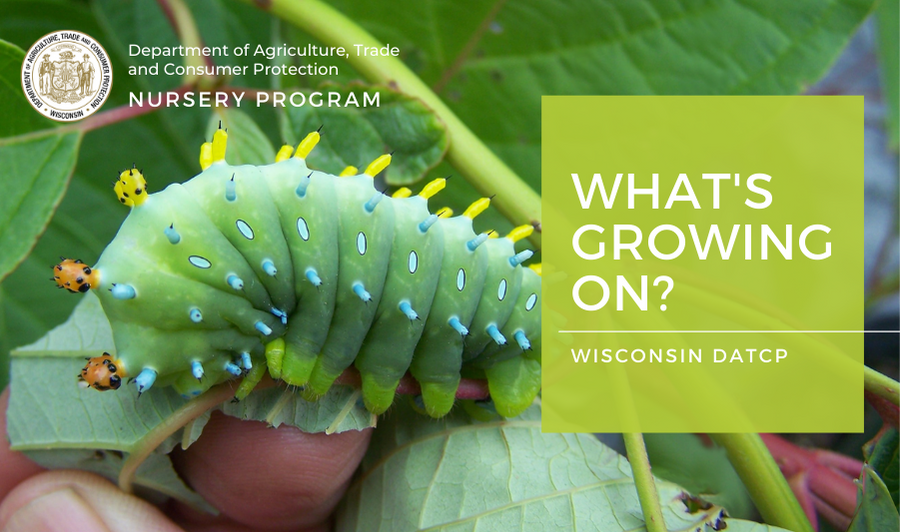 _____________________________________
Dear Wisconsin nurseries, Christmas tree growers, and gardeners:
Growing degree days (GDD)(simple B50) as of July 13 were 835 in Bayfield, 952 in Medford, 1004 in Wausau, 1154 in Hancock, 1202 in Green Bay, 1135 in Racine, 1334 in Madison, and 1404 in La Crosse. A few pests and diseases in a vulnerable-to-treatment stage include: adult black vine weevil, adult Japanese beetle and European pine shoot moth egg hatch (900-1000 GDDB50); two spotted spider mite (900-1100 GGDB50); and cottony maple scale, European elm scale, fletcher scale, lecanium scale and cedar hawthorn rust (900-1200 GDDB50).
Take a moment to read through a few updates from the DATCP nursery and other Plant Protection programs. Please send any feedback, questions, or ideas for future e-news updates to datcpnursery@wisconsin.gov.
Having trouble viewing this email? View it as a Web page.
_____________________________________
|
|
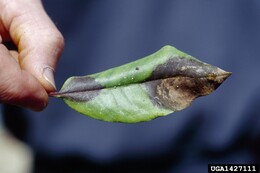 Phytophthora ramorum on a Rhododendron leaf. | Joseph OBrian, USDA Forest Service, Bugwood.org
|
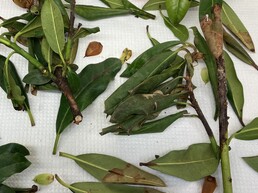 Phytophthora ramorum causing shoot dieback on a 'Holden' rhododendron. | DATCP E. Voigt
|
|
|
Phytophthora ramorum is a plant pathogen that causes the diseases known as sudden oak death on oak trees and Ramorum blight on other plant species. Sudden oak death has caused devastating tree mortality in the coastal forests of California and Oregon since the mid-1990s. Ramorum blight can occur on over 100 plant species, including common horticultural plants such as rhododendron, lilac, and viburnum. A full list of known hosts can be found on the USDA website.
Symptoms of Ramorum blight include leaf spots, shoot blight, branch dieback, and wilting (see included images). Additional images of symptoms on different hosts can be found here.
DATCP has an external quarantine on items that could harbor and spread P. ramorum. An external quarantine means that items including nursery stock, unprocessed wood, soil, and other plants and plant parts cannot be brought into Wisconsin from areas where the pathogen is known to occur without an inspection and certificate from the exporting state. More information on this external quarantine is available on the DATCP website.
While DATCP has occasionally intercepted P. ramorum on imported nursery stock, to date P. ramorum has never been detected on plants in the Wisconsin landscape. DATCP had its first confirmed detection of P. ramorum at a Wisconsin nursery in 2019. This was after being notified that a Washington nursery had shipped over 4,000 rhododendrons and 400 azaleas potentially infected with P. ramorum to two Wisconsin nurseries, which then redistributed them to 59 nursery locations. Follow-up inspections at those nurseries that same month resulted in the collection of a single symptomatic rhododendron that tested positive for P. ramorum. The nursery promptly destroyed all host plants, soil, and pots within a 4-meter radius of the detection.
In June 2023, staff observed symptomatic rhododendrons during routine inspections that led to 15 confirmed detections of P. ramorum at a licensed nursery dealer that imported infected plants from Oregon earlier this spring. These detections were discovered on 12 ‘Holden’ rhododendrons, one ‘Nova Zembla’, one ‘Purple Passion’, and one ‘Maxecat’ rhododendron. All interceptions of P. ramorum-infected plant material were properly contained, disposed of, and the nurseries disinfected as required by USDA regulation.
Early detection of this pathogen is key to protecting Wisconsin green industries. If you are a licensed nursery grower and suspect you may have plants infected with P. ramorum, please contact DATCP’s nursery program at (608) 516-7617 or DATCPnursery@wisconsin.gov. If you are a home gardener or horticulture professional and suspect you may have plants infected with P. ramorum, contact the University of Wisconsin–Madison Plant Disease Diagnostic Clinic at (608) 262-2863 or bdh@plantpath.wisc.edu.
_____________________________________
|
|
 Box tree moth larvae feeding on boxwood | USDA-APHIS image
|
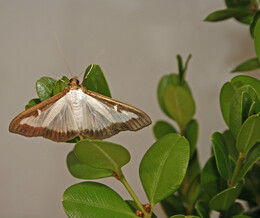 Box tree moth adult | USDA-APHIS image
|
|
|
The U.S. Department of Agriculture’s (USDA) Animal and Plant Health Inspection Service (APHIS) has confirmed the detection of the box tree moth (BTM) in the following states: New York in 2021; Michigan in 2022; and as of June 2023, Ohio. BTM was first detected in North America in the Toronto area of Canada in 2018. Following the detection of BTM at a nursery in St. Catherine's, Ontario in 2021, APHIS amended entry requirements to prohibit the import of any Buxus (boxwood), Ilex (holly), or Euonymous shrubs from Canada into the United States. While box tree moth has never been detected in Wisconsin, inspectors removed and destroyed potentially infested plants from four residential locations in 2021. These residents had purchased boxwood online from a South Carolina nursery that in turn had received potentially infected boxwood from the nursery in St. Catherine’s, Ontario. Counties in Michigan and New York, where BTM have been detected, are under quarantine. Infested counties in Ohio will likely be under quarantine soon. The domestic quarantine prohibits all Buxus species, varieties, and hybrids from leaving the quarantined areas in order to prevent the artificial spread of box tree moth.
This invasive box tree moth is native to China, Japan, and Korea, and has been introduced into other areas of Asia, Europe, and North America. The box tree moth, Cydalima perspectalis, is a major threat to the horticulture industry, specifically feeding on boxwood plants, a popular ornamental shrub.
BTM caterpillars are green and yellow with white, yellow, and black stripes and black spots. Adult BTMs have brown and white color forms and are nocturnal. Moths have white, slightly iridescent wings, with an irregular thick brown border. The second adult color form is completely brown with a small white comma-shaped streak on the forewings. Both males and females can show these colorations.
Larvae can quickly defoliate an entire boxwood shrub or hedgerow, depending on infestation levels, during its development. Signs of feeding include: chewed, cut, or missing leaves; yellowing or brown leaves; white webbing; and green-black excrement on or around the plant. To report suspected box tree sightings or symptoms, contact the DATCP Pest Hotline at (866) 440-7523 or datcppesthotline@wi.gov
_____________________________________
|
|
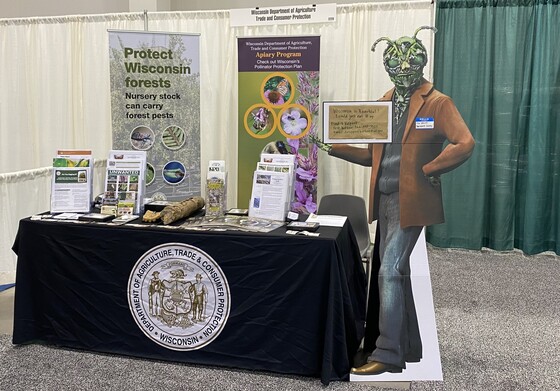 DATCP booth at one of multiple tradeshows | DATCP L. Meils
DATCP's staff will be exhibiting at some upcoming events. Stop by to visit with us and learn about the latest plant pest and disease issues.
July 18-20 - Farm Technology Days in Baraboo
Visit DATCP’s Farm Center team in the Progress Pavilion to learn more about the free and confidential services available to farmers and their families, including financial consulting, transition planning, mediation, veterinary analysis, and access to mental health services and resources. You can also find USDA-APHIS-PPQ staff with information about plant pests that threaten Wisconsin’s environment and agriculture such as Emerald Ash Borer, Asian Longhorned Beetle, and Spotted Lanternfly.
August 3-13 - Wisconsin State Fair in West Allis
DATCP will have a booth in the Products Pavilion. This year the theme is "Working for Wisconsin." Outreach will include information on invasive pests like spotted lanternfly and spongy moth.
August 8-10 - Garden Center Show in Milwaukee
DATCP's Plant Protection section will be in booth #1917 offering information about the latest pests and pathogens of concern.
August 24-26 - Wisconsin Christmas Tree Producers Association Summer Convention in Niagara, WI (Marinette Co.).
_____________________________________
|
|
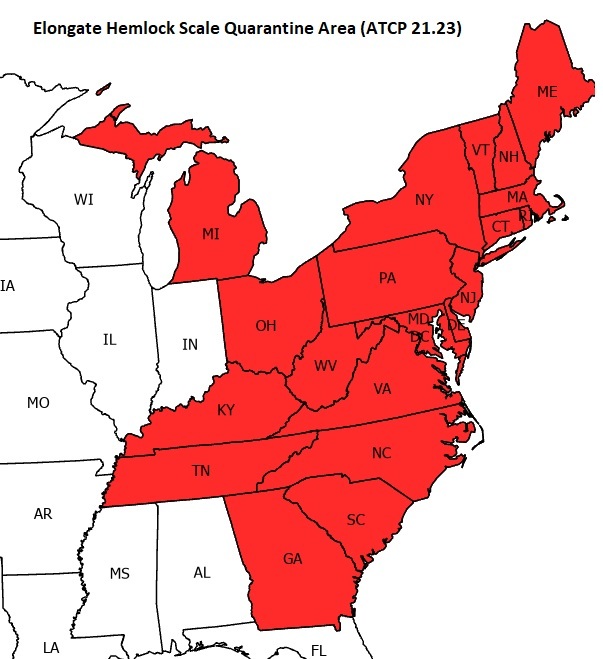 Map of EHS-infested states | DATCP
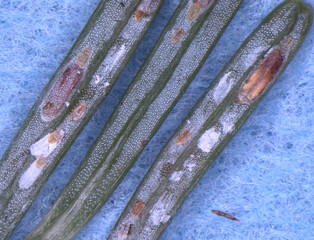
As of July 1, 2023, a permanent rule change went into effect for ATCP 21, related to plant inspections and pest control. Quarantines were removed for pine shoot beetle (ATCP 21.12), emerald ash borer (ATCP 21.17), and thousand cankers disease (ATCP 21.21) due to lack of serious pest impacts, the quarantine outliving its ability to contain the pest, federal deregulation, or a combination of these factors. Quarantine revisions were made for hemlock woolly adelgid (ATCP 21.16) and Phytophthora ramorum (ATCP 21.19) to ensure documented infested areas, host range, and regulated articles reflect best available science, current pest distribution, and host associations. Additionally, a new exterior quarantine was created for elongate hemlock scale (ATCP 21.23). (image above right: white EHS winged males, brown female scale adults, yellow eggs & nymph stages on the undersides of fir needles, DATCP)
Elongate hemlock scale (EHS) is an invasive, introduced, cold-hardy pest from Japan that can weaken or otherwise harm conifers by attaching to the underside of needles and sucking on needle fluid. EHS feeding leads to needle yellowing, needle loss, and tree mortality, especially in combination with other stressors, like drought. Because EHS crawlers emerge throughout the year, and because other life stages live under hard, waxy, protective scale coverings, it is hard to control with pesticides and some systemic products, like imidacloprid, will not control this pest. EHS poses a serious threat to the Christmas tree industry and our unique, native hemlock and balsam fir forests in Wisconsin. This pest, which can live for weeks on cut plant material, has been intercepted dozens of times since 2014 by inspectors on out-of-state plant products such as cut fir Christmas trees, fir wreaths, and hemlock nursery stock. EHS is not currently established in Wisconsin, and an EHS quarantine will help keep it that way, since this pest spreads very slowly on its own.
An EHS compliance agreement is required for any business that brings in hemlock and/or fir (the favorite hosts of EHS) from an EHS-infested area: Connecticut, Delaware, Georgia, Kentucky, Maine, Maryland, Massachusetts, Michigan, New Hampshire, New Jersey, New York, North Carolina, Ohio, Pennsylvania, Rhode Island, South Carolina, Tennessee, Vermont, Virginia, West Virginia, and Washington D.C. This compliance agreement is an annual agreement between your business and DATCP that offers a limited exemption to the EHS quarantine, provided that appropriate risk reduction measures are taken. The agreement requires documentation showing imported material has been inspected and confirmed free from EHS or treated to destroy EHS. Alternatively, Wisconsin businesses can legally import a hemlock or fir shipment from the quarantine area if it is accompanied by a state phytosanitary certificate issued in the state of origin. We are reaching out to nursery growers/dealers, Christmas tree producers, wreathmakers, and others who import hemlock and fir from an EHS-infested area to facilitate understanding and compliance with the new regulation. We are hopeful these permanent changes to ATCP 21 will help protect our native forests and green industry from invasive pests like EHS for years to come.
Please contact Shahla.Werner@wisconsin.gov with questions about updates to the ATCP 21 rule. If you think you may need an EHS compliance agreement, please contact MeganT.Sanders@wisconsin.gov
|
_____________________________________
|
|
|
|
|